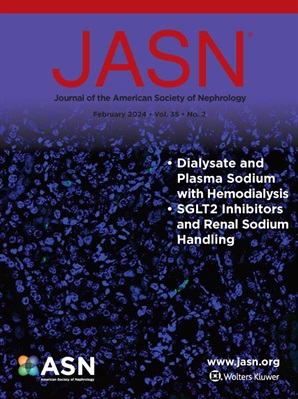Interplay between Skeletal Muscle Catabolism and Remodeling of Arteriovenous Fistula via YAP1 Signaling.
IF 10.3
1区 医学
Q1 UROLOGY & NEPHROLOGY
引用次数: 0
Abstract
BACKGROUND Arteriovenous (AV) fistulas are the preferred access for dialysis but have a high incidence of failure. This study aims to understand the crosstalk between skeletal muscle catabolism and AV fistula maturation failure. METHODS Skeletal muscle metabolism and AV fistula maturation were evaluated in mice with chronic kidney disease (CKD). The roles of myostatin and YAP1 in regulating the transdifferentiation of adventitial mesenchymal stem cells (mesenchymal stem cells) and intima hyperplasia in AV fistula were investigated. Nanoparticles carrying a YAP1 inhibitor, verteporfin, with light irradiation-controlled release were synthesized and applied to AV fistula. RESULTS Increased trichrome signals and stenosis were observed in AV fistulas from mice treated with myostatin and from mice with CKD. In contrast, blocking myostatin function with an anti-myostatin peptibody not only improved body weight and muscle size in CKD mice but also decreased neointima formation in AV fistulas. In cultured mesenchymal stem cells, myostatin induced YAP1 expression, promoting the differentiation of mesenchymal stem cells into myofibroblasts and inducing extracellular matrix deposition. Red light irradiation-controlled release of verteporfin from nanoparticles blocked YAP1 activation and alleviated myostatin-induced mesenchymal stem cell activation. Periadventitial application and red-light irradiation of nanoparticles carrying verteporfin significantly suppressed stiffening and neointima formation in AV fistula. CONCLUSIONS CKD induced muscle wasting leading to increased production of myostatin, which stimulated mesenchymal stem cell activation and vascular fibrosis linked to AV fistula stenosis. YAP1 signaling was activated in these processes. Red-light irradiation-controlled release of verteporfin offered a feasible approach for local vascular drug intervention to improve AV fistula maturation.求助全文
约1分钟内获得全文
求助全文
来源期刊
CiteScore
22.40
自引率
2.90%
发文量
492
审稿时长
3-8 weeks
期刊介绍:
The Journal of the American Society of Nephrology (JASN) stands as the preeminent kidney journal globally, offering an exceptional synthesis of cutting-edge basic research, clinical epidemiology, meta-analysis, and relevant editorial content. Representing a comprehensive resource, JASN encompasses clinical research, editorials distilling key findings, perspectives, and timely reviews.
Editorials are skillfully crafted to elucidate the essential insights of the parent article, while JASN actively encourages the submission of Letters to the Editor discussing recently published articles. The reviews featured in JASN are consistently erudite and comprehensive, providing thorough coverage of respective fields. Since its inception in July 1990, JASN has been a monthly publication.
JASN publishes original research reports and editorial content across a spectrum of basic and clinical science relevant to the broad discipline of nephrology. Topics covered include renal cell biology, developmental biology of the kidney, genetics of kidney disease, cell and transport physiology, hemodynamics and vascular regulation, mechanisms of blood pressure regulation, renal immunology, kidney pathology, pathophysiology of kidney diseases, nephrolithiasis, clinical nephrology (including dialysis and transplantation), and hypertension. Furthermore, articles addressing healthcare policy and care delivery issues relevant to nephrology are warmly welcomed.

 求助内容:
求助内容: 应助结果提醒方式:
应助结果提醒方式:


